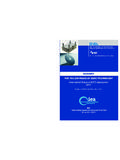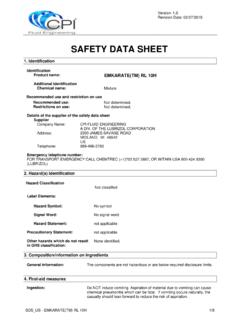Transcription of The implementation of European Directives and Regulations ...
1 The implementation of European Directivesand Regulations : Opportunities or threatsfor fuel cell systems?IEA AFC annex 33, Subtask 3 Report 2016 SUBTASK REPORTA uthors:Ing. Mag. Alfred SchuchDavid Presch, BScDI Dr. G nter R. SimaderClient:FFGBMVITDate:Vienna, M rz 2017 This report was compiled within annex 33 Subtask 3: The implementation of the new Buildingsand energy Directives : Opportunities or threats for fuel cell systemsCurrently the following countries participate in this annex : USA, Japan, Germany, France, Italy,Sweden, Swiss, Denmark, Australia, Israel and and produced by: sterreichische Energieagentur Austrian Energy AgencyMariahilfer Stra e 136, A-1150 Vienna, Phone +43 (1) 586 15 24, Fax +43 (1) 586 15 24 - 340E-Mail: Internet: in Chief.
2 DI Peter Traupmann | Project management: Dr. G nter SimaderProduced and published in ViennaReprint allowed in parts and with detailed reference only. Printed on non-chlorine bleached paperThe Austrian Energy Agency has compiled the contents of this study with meticulous care and to the best of its , we cannot assume any liability for the up-to-dateness, completeness or accuracy of any of the ! ANV ND FLIKEN START OM DU VILL TILL MPA BERSCHRIFT 1 F R TEXTEN SOM SKA VISAS H specific goal of this report is to identify and to analyse upcoming opportunities or possible threats for themarket uptake of fuel cell systems through the implementation of various EU Directives and Regulations indifferent countries.
3 The specific impact has been carried out among the participants of the IEA Advanced FuelCell Implementing Agreement annex 33 Stationary fuel anticipated impact of the implementation of EU Directives in different member states on the market uptakeof fuel cell systems has been elaborated on the basis of the implementation in Austria and Germany. These twocountries have been chosen as representative example cases for the implementation of different EU directivesand implementation of the Ecodesign and Labelling Directive encourages high efficient products.
4 The EcodesignDirective provides minimum requirements that appliances have to fulfil in order to be placed on the it can be stated that those minimum requirements are fulfilled from state of the art fuel cell CHPsystems. Through the Labelling Directive the efficiency of a product is now visible for the costumers. It isanticipated that especially highly efficient systems like fuel cell mCHP`s can take advantages from theimplementation of these two the implementation of the Buildings Directive in Austria, the efficiency of the heating systems becamemore and more part of the requirements.
5 This leads to an encouragement of highly efficient heating systems likeCHP systems (incl. fuel cells).The Energy Efficiency Directive requires member states to adopt policies which encourage the due taking intoaccount of the potential of using efficient heating and cooling systems in particular those systems using high-efficiency cogeneration (incl. fuel cell). It is anticipated that this requirement led to a favourable framework interms of investment grants and subsidies in both 2009/73/Ec on the common rules for the internal market in natural gas and directive 2009/72/EC onthe common rules for the internal market in electricity provide a framework for the internal market in naturalgas and electricity including rules for the tariffs for the usage of the gas- respectively eletricity infrastructure,like transmission and distribution grids.
6 In case of a proper infrastructure tariffs-structure for gas as well as forelectricity grids, strong incentives could be generated for the market introduction and further on significantmarket penetration (part of the business model) of fuel the European Union, Germany has put in place the most extensive policy support for stationary fuel celltechnologies both at federal and at state level. In addition to the present favourable framework for fuel cellsin Germany the implementation of different EU Directives brought further benefits for fuel cell systems.
7 Oneexample is the requirement regarding renewables in buildings: For all new buildings, a certain share of renewableenergy sources to cover the heating and domestic hot water demand is mandatory. The exact ratio depends onthe chosen energy source and varies between 15% and 50%. Alternatively, the renewable energy heat act allowseither an energy performance of 15% better than required by the Energy Saving Ordinance, or the use of districtheating and combined heat and power (CHP incl. fuel cell) instead of renewable energy sources. The fact thatthe use of CHP heating systems neutralizes the requirements regarding renewable energy sources encouragesthe use of CHP implementation OF European Directives AND Regulations : OPPORTUNITIES OR THREATS FOR FUELCELL SYSTEMS?
8 And report Climate and energy cell systems in the fuel cells in Europe s future energy challenges to overcome112 POLICY FRAMEWORK IN THE EU Directives and on the indication by labelling and standard product information of the consumption ofenergy and other resources by energy related for establishing a framework for the setting of ecodesign requirements for on the energy performance of on energy on the promotion of the use of energy from renewable 2009/73/EC on the common rules for the internal market in natural 2009/72/EC on the common rules for the internal market in of EU Directives in different Member FRAMEWORK IN OTHER WORLD Activities & Policy and Fuel States of Activities & Policy and Fuel Activities & Policy and Fuel Cells61 FEL!
9 ANV ND FLIKEN START OM DU VILL TILL MPA BERSCHRIFT 1 F R TEXTEN SOM SKA VISAS H OF FIGURES718 LIST OF TABLES739 INDEX OF 1 EU77 THE implementation OF European Directives AND Regulations : OPPORTUNITIES OR THREATS FOR FUELCELL SYSTEMS?41 IntroductionAlongside direct and indirect financial mechanisms, innovation needs to be pushed by a favourable regulatoryframework. Experience in the renewable sector was demonstrated that long-term political and regulatoryperspectives create the right stimulus for market-uptake including private investments.
10 Clear political directionand commitment, for example in the form of binding targets and broad integration in EU energy and climatepolicies, proved to be instrumental in retaining investors specific goal of Subtask 3 is to identify and analyse upcoming opportunities or possible threats for the marketuptake of fuel cell systems through the implementation of various EU Directives and Regulations in differentcountries. In addition to this different subsidy schemes / political frame conditions in various countries and worldregions should be recorded and analysed in order to compare different measures to strengthen the marketuptake of fuel cell and report structureAt the beginning of the following report the EU energy and climate policy is summarised.






